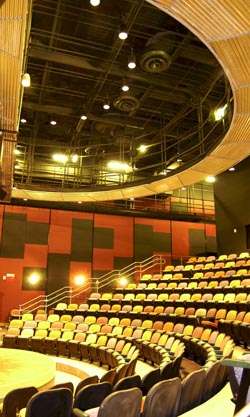- Charlotte, NC-Occupying an entire block of uptown Charlotte, NC with 114,000 square feet of space, ImaginOn houses cutting-edge library services and collections, innovative education programs, and award-winning professional theater, all for young people and their families. A collaborative venture of the Public Library of Charlotte and Mecklenburg County and the Children's Theatre of Charlotte, ImaginOn opened with two state-of-the-art performance halls with shop and support spaces, all under one roof. Children's Theatre of Charlotte runs the two theater spaces where a full season of professional, adult productions for young people is offered.
The Wachovia Theatre in Charlotte, NC's ImaginOn space features an unobtrusive EAW MQM-DF center cluster, EAW MK2264s on the left and right, plus two SB180P subwoofers.
ImaginOn is the work of Holzman Moss Architecture, New York, NY (with Gantt Huberman Architects, Charlotte, NC). Acoustic consultants Jaffe Holden of Norwalk, CT, were responsible for the acoustic and audio systems design of both theaters, the 570-seat McColl and the 250-seat Wachovia.
"From an acoustical standpoint, design for such spaces with fixed acoustics is more straight-forward," said Jaffe Holden architectural acoustic design consultant, Mark Reber. "But the execution of the design still has its own flavor and surprises." The original design concept for both theaters called for Masonite peg board as the finish wall material. It was originally specified for the curved ceiling as well as the walls in McColl.
"The rear of the hall, a curved surface, is mostly sound-absorptive material," Reber noted. "The front of the hall, mostly the side walls, is sound-reflective. This is helpful in reflecting sound from the stage back to the audience, supplementing the direct sound, and actually enhancing voice intelligibility and clarity."
Once acoustic design challenges for the theaters were met, design for the venues' audio systems was far less problematic. "From an audio standpoint," said Jaffe Holden senior audio consultant, David LaDue, "if the program does not involve acoustic music performance, the drier the hall acoustic, the better. There is more sonic energy control in a dry space. For amplified musical program material, if the theater company wants to add reverberation, they have the ability to add it electronically without having to fight the natural acoustics of a live room."
Equipment for both theaters was selected to meet the Children's Theatre's level of use and budget. Front-of-house loudspeaker systems consist of EAW loudspeakers powered by QSC amplifiers. For the 570-seat McColl: two EAW KF300e loudspeakers and one SB330e (center cluster, top tier); one MQM-DF (center cluster, bottom tier); two JFX260zs and two JFX290zs (upper and lower side proscenium, respectively); two SB180P subwoofers; and five EAW UB12Se-70V (front fills). Effects monitors are four EAW UB12Ses, four JF80s, and four SM122e portables. A total of 13 QSC CX series amplifiers are configured to the outputs of the system's EAW MX8750 digital signal processors. The smaller-scale Wachovia Theatre is covered by a center cluster (an EAW MQM-DF), left and right speakers (EAW MK2264s), plus two SB180P subwoofers, also powered by QSC with EAW digital signal processing.
These are sound systems that do not call attention to themselves. "When used for slight amplification of children's and untrained voices, the system is very discrete," LaDue said. "Most theatergoers would not notice that sound was being amplified at all. This is both a function of the sound system design as well as the sound designer's skill."
